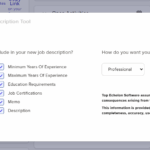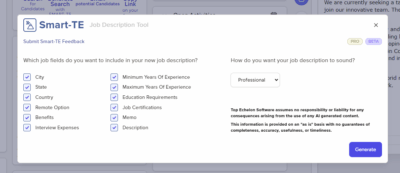Exit interview software is a digital tool that helps organizations conduct interviews with departing employees in a structured and efficient manner. Exit interviews are typically conducted when employees leave a company, either voluntarily or involuntarily.
The purpose of these interviews is to gather feedback from employees about their experiences working for the company, the reasons for their departure, and any suggestions they may have for improving the organization. Exit interview software streamlines the process of conducting these interviews by automating many of the tasks involved, such as scheduling interviews, recording responses, and analyzing data.
What is exit interview software?
Exit interview software is typically cloud-based and accessible from any device with an internet connection. The software provides a centralized platform where HR professionals can manage the exit interview process. This includes creating customized questionnaires, scheduling interviews, sending invitations to departing employees, and tracking response rates. The software can also automate reminders to ensure that interviews are conducted in a timely manner.
The questionnaires used in exit interview software can be customized to meet the specific needs of the organization. HR professionals can choose from a variety of pre-designed questions or create their own. The questions typically cover a range of topics, such as the employee’s reason for leaving, their experience working for the company, the company’s culture and management practices, and suggestions for improvement. By gathering feedback from departing employees, organizations can gain insights into the factors that influence employee turnover and make data-driven decisions to improve employee retention.
One of the key benefits of using exit interview software is that it helps organizations identify patterns and trends in employee feedback. The software can generate reports that summarize the responses to exit interviews, allowing HR professionals to identify common themes and areas for improvement. For example, if multiple employees cite poor management practices as a reason for leaving, HR professionals can take steps to address this issue. By analyzing exit interview data, organizations can make targeted improvements to their policies, practices, and culture to improve employee retention.
Another benefit of using exit interview software is that it can help organizations comply with legal and regulatory requirements. For example, in some industries, employers are required to conduct exit interviews as part of their compliance with employment laws. Exit interview software can help organizations meet these requirements by ensuring that interviews are conducted in a consistent and structured manner, and by providing a centralized platform for storing interview data.
Overall, exit interview software is a valuable tool for organizations that want to improve employee retention and gather feedback from departing employees. By streamlining the exit interview process and providing a centralized platform for managing interview data, organizations can gain insights into the factors that influence employee turnover and make data-driven decisions to improve employee retention. Additionally, exit interview software can help organizations comply with legal and regulatory requirements related to employee turnover.
Exit interview software best practices
While exit interviews are often associated with employee departures, they can also be a valuable tool for recruiting and hiring top talent. By gathering feedback from departing employees, organizations can gain insights into their strengths and weaknesses as an employer, and use that information to attract and retain top talent. Here are some best practices for using exit interview software to recruit and hire top talent:
Use the data to improve your employer brand: Exit interviews can provide valuable feedback on your organization’s employer brand. Employer brand refers to the reputation of your organization as an employer, and it can play a significant role in attracting top talent. By analyzing the feedback from exit interviews, you can identify areas where your employer brand may be weak, and take steps to improve it. For example, if employees consistently mention poor communication as a reason for leaving, you may need to improve your internal communication processes to enhance your employer brand.
Use the data to improve your recruitment and hiring processes: Exit interviews can also provide insights into your recruitment and hiring processes. For example, if multiple departing employees mention a poor onboarding experience, you may need to revise your onboarding program to ensure that new hires feel welcomed and prepared for their roles. By improving your recruitment and hiring processes, you can attract and retain top talent.
Address employee concerns in a timely manner: When employees raise concerns during exit interviews, it’s important to address them in a timely manner. Failing to address employee concerns can lead to negative feedback and damage your employer brand. By addressing concerns promptly, you can show that you value employee feedback and are committed to improving as an employer.
Use the data to identify training and development opportunities: Exit interviews can also provide insights into training and development opportunities. For example, if multiple employees mention a lack of career advancement opportunities as a reason for leaving, you may need to develop a more robust career development program to retain top talent. By providing opportunities for growth and development, you can attract and retain top talent.
Use the data to identify opportunities for employee engagement: Employee engagement refers to the extent to which employees feel connected to their work, their colleagues, and their organization. Engaged employees are more likely to stay with their current employer and perform at a high level. Exit interviews can provide insights into employee engagement levels, and identify areas where engagement can be improved. For example, if multiple employees mention a lack of recognition as a reason for leaving, you may need to implement an employee recognition program to improve engagement and retain top talent.
Communicate the results of exit interviews to relevant stakeholders: Finally, it’s important to communicate the results of exit interviews to relevant stakeholders. This includes HR professionals, managers, and other decision-makers. By sharing the results of exit interviews, you can demonstrate the importance of employee feedback and gain support for initiatives to improve employee retention and attract top talent.
Exit interview software can be a valuable tool for recruiting and hiring top talent. By gathering feedback from departing employees, organizations can gain insights into their strengths and weaknesses as an employer, and use that information to improve their employer brand, recruitment and hiring processes, training and development programs, employee engagement, and more. By following these best practices, organizations can use exit interview software to attract and retain top talent and improve their overall performance as an employer.








